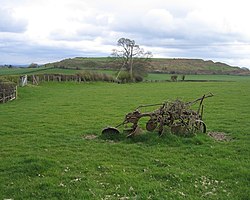Old Oswestry
| Old Oswestry | |
|
Shropshire | |
|---|---|
 Old Oswestry hill fort | |
| Type: | Hill fort |
| Location | |
| Grid reference: | SJ295311 |
| Location: | 52°52’22"N, 3°2’56"W |
| History | |
| Information | |
| Owned by: | English Heritage |
| Website: | Old Oswestry Hill Fort |
Old Oswestry is one of Britain's most spectacular and impressive early Iron Age hill forts. It is found near Oswestry in north-western Shropshire. Old Oswestry Hillfort has been described as "The Stonehenge of the Iron Age Period"[1] but, taking account of exaggeration, it does remain one of the best preserved hill forts in the British Isles, according to English Heritage.
After the hill fort was abandoned it was incorporated into Wat's Dyke, and two sections of this are adjacent to it.[2]
The fort Is built on lower ground, and it is consequently one of the most accessible hill forts, but provides stunning views across North Wales, Cheshire and Shropshire.
The fort has been designated as a scheduled ancient monument.[3] It is now in the guardianship of English Heritage.
Iron Age Hillfort
The fort was occupied between the eighth century BC and the Roman conquest of Britain, probably by the Cornovii tribe or the Ordivice tribe.[2][4]
Several phases
The complexity of its defences suggests several phases of development. The site was originally occupied by a few undefended round huts. These were then enclosed by a double bank and ditch enclosure spreading over 13 acres. Entrances were placed through the enclosure at the east and west ends where the inner bank was pulled back inwards to create a more impressive gateway. These defenses were later rebuilt and a third bank added on all sides except the south east where the hill's steep slope made further strengthening unnecessary. The western entrance was then remodeled with unusual rectangular hollows separated by ridges dug out and defended by outworks. Finally two further circuits of banks and ditches were added to the outside and a flanking bank placed alongside the eastern entrance.[2]
Although Old Oswestry was one of the most strongly defended hill forts in Britain there is no evidence that the Roman Legions ever tried to besiege it.
Later use
Old Oswestry is thought to be the location of Maserfelþ, the battlefield at which King Oswald of Northumbria fell, defeated by Penda of Mercia. The town of Oswestry is named after the martyred king.
During the First First World Wart was used as a training area for Canadian troops. Many of the large pits and trenches shown on aerial photographs relate to these military activities.[2]
Outside links
| ("Wikimedia Commons" has material about Old Oswestry) |
- Old Oswestry Hill Fort – English Heritage
- Ancient Britain - Old Oswestry
- Pictures of Old Oswestry and the area on Geograph.co.uk
References
- ↑ Dr Rachel Pope, University of Liverpool
- ↑ 2.0 2.1 2.2 2.3 Old Oswestry Hill Fort: History and research
- ↑ National Heritage List 27556: Old Oswestry
- ↑ National Monuments Record: No. 66112